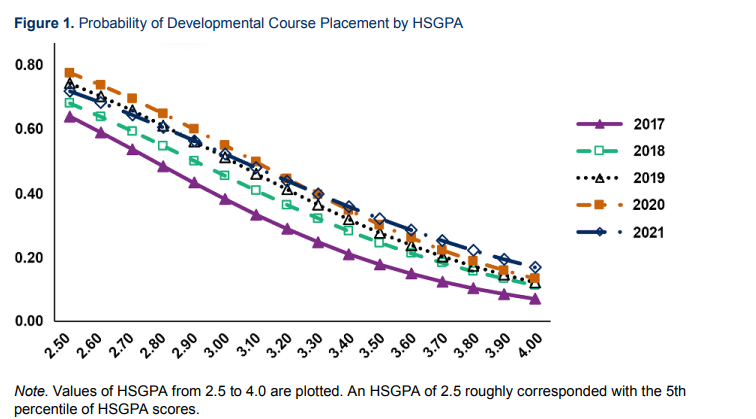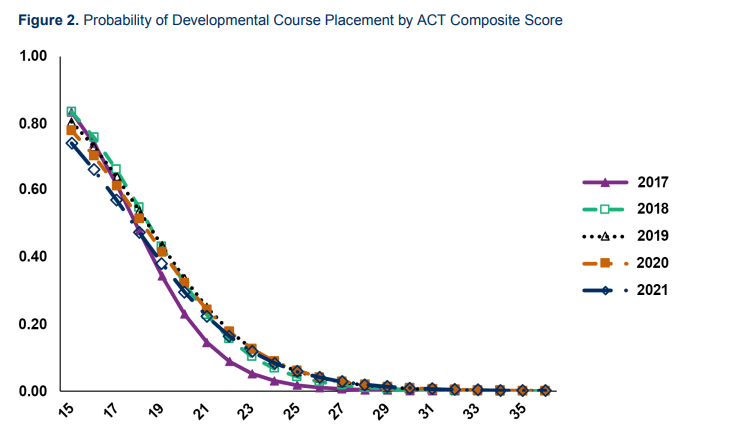You have /5 articles left.
Sign up for a free account or log in.

Students’ rate of placement in a developmental or remedial math course was higher for learners entering college between 2019 to 2021, possibly tied to grade inflation due to COVID-19, according to a new ACT study.
PeopleImages/E+/Getty Images
Remote instruction due to the COVID-19 pandemic impacted current and future college students’ learning, and new research points to how colleges and universities are responding to grade inflation with remedial course placement.
A May 22 report by ACT found students who entered college from 2019 to 2021 were more likely to be placed into developmental or remedial courses based on their high school GPA compared to their peers who entered college before then. The observed changes may be a sign that colleges are adjusting their interpretation of high school grades due to grade inflation, according to report author Edgar I. Sanchez, lead research scientist at ACT.
In response, Sanchez recommends colleges place students into developmental courses looking at multiple measures, rather than a single criterion such as GPA or test scores. “This approach aligns with best practices and can lead to a more equitable and effective education journey for students,” he writes.
State of play: Previous research points to the value of remedial education—if the student successfully completes the course—in boosting attainment and retention as well as in resolving skill deficiencies, but these courses have come under scrutiny because they can delay time to degree as students struggle to complete a noncredit course.
A 2016 report from the National Center for Education statistics found more than two-thirds of community college students and 40 percent of undergraduates at four-year institutions completed at least one remedial class. A majority of remedial students stopped out prior to attaining a credential.
Some states and systems have done away with remedial course offerings, instead providing supplemental instruction or corequisite courses to bring learners up to speed with college readiness.
When deciding where to place students in their introductory courses, some colleges use multiple measures such as ACT scores or high school GPA, but Sanchez’s study suggests decision-makers at colleges were more likely to put students into developmental math using strict cutoffs to group students due to grade inflation concerns.
The average cumulative high school grade point average has risen over the past few decades, growing from 3.22 in 2010 to 3.39 in 2021, while the average ACT composite score declined, from 21.40 to 20.17, respectively, which experts say could be a sign of grade inflation.
In admissions, selective institutions have reinstated mandatory standardized test requirements, which leaders say is in light of declining rigor in grading and pandemic-related learning loss that makes it hard to gauge college readiness.
Methodology
The study focuses on one state that provides the ACT test to all 11th grade students during the school day, focusing on high school graduates and currently enrolled college students at four-year institutions in that state from 2017 to 2021.
The total sample included 40,194 students from 10 institutions who provided high school GPA during testing and ACT scores as earned by July of their high school graduation year.
Colleges in the study used several placement criteria, including standardized tests, high school performance, student motivation to succeed and other predictive analysis measures.
The study: When evaluating the study sample, the average high school GPA increased from 3.4 in 2017 to 3.6 in 2021 (out of 4.0), while the ACT composite score decreased from 22.3 to 21.9 (out of 36), respectively. The number of students taking developmental math, however, grew from 17.8 percent in 2017 to 24.3 percent in 2021.
As expected, a student’s probability of being placed in developmental math declined as their GPA rose, with students who had a 3.3 or higher least likely to take a remedial course.
But when comparing students across cohorts, those entering college in 2020 or 2021 with a 3.0 GPA had a 55 percent or 52 percent chance, respectively, of taking remedial courses, compared to 38 percent of 2017 students and 45 percent of 2018 students.

Student high school GPA versus rate of placement in developmental courses in college from 2017–2021
ACT
When looking at students’ ACT scores, students who scored 18 had similar odds of being placed in developmental courses across the five cohorts, as did students who scored at least 21 (with the exception of 2017, which had lower rates of developmental course placement for anyone scoring between 18 to 25), showing little variation between pre- and post-pandemic students.

Student ACT courses compared to rate of placement in developmental courses from 2017–2022
ACT
When looking at GPA and ACT scores together, students with lower GPAs were more likely to be placed in developmental courses compared to their peers who scored the same as them on the ACT but earned higher high school grades.
“This illustrates that colleges interpreted increases in HSGPA [high school GPA] as an increase in college course readiness above and beyond readiness as indicated by ACT Composite score,” Sanchez writes. “This may also suggest that colleges are interpreting ACT scores as more stable over time for students with higher HSGPAs, relative to students with low HSGPAs. In the context of a grade inflation lens, it may be that colleges are more concerned about grade inflation at lower levels of HSGPA than at higher levels of HSGPA.”
So what? Based on his findings, Sanchez recommends colleges adopt a holistic approach to developmental course placement, as the ACT and GPA mapped together had less variation in placement over time.
“In practice, it may be easier to use only a single measure for developmental course placement; however, using multiple measures allows for a compensatory methodology to better understand student performance and preparation for college,” Sanchez says.




